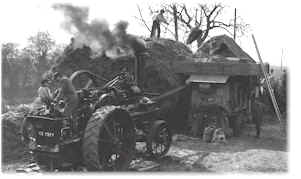“Oliver” the ‘Little Ruston’

“…only a six horse engine, but it had to do the work of a seven horse…”Over heard at a rally during a conversation about the late Bob Pumfrey, engineman extraordinaire and driver at times of the “Little Ruston”.
Oliver is a ‘general purpose traction engine’ and was built by Ruston & Hornsby Ltd of Lincoln in 1920. According to Ruston’s order books, the engine was ordered at the Bath & West Show in February 1920 by W. Godfrey & Sons of Ickleton, in Cambridgeshire and was completed ready for delivery on 15th June. The engine was put to use,as far as can be determined, hauling timber and powering a saw bench in the Godfrey’s workshop at Ickleton.During 1921, the Godfrey’s replaced the traction engine with a Ruston oil engine to drive the machinery, and sold the traction engine to nearby Coxhalls of Hinxton, who were thrashing contractors. However, in 1924 a disastrous fire destroyed their thrashing machinery, and although badly scorched, their traction engine survived and was sold on to C. R. Pumfrey & Sons of Duxford.Having been repaired and repainted, the engine was put to work driving a new Ruston & Hornsby 54″ thrashing machine, a 22ft Garrett Straw Pitcher and a five-knife Maynard Chaff Cutter. Pumfrey’s other thrashing engines were all bigger, and consequently the ‘Little Ruston’, as they referred to it, had a special thrashing round, consisting of all the awkward stack yards and gate ways, where it was easier to manoeuvre the engine due to its shorter wheelbase. The driver at this time was Sidney Pumfrey – often assisted by his son Dick Pumfrey.The ‘Little Ruston’ was used commercially by the Pumfrey’s up until the early 1950’s when it was sold for scrap along with their other traction engines (another Ruston and a Burrell) for £12 each. Having seen the Burrell engine cut up by the scrap man Robert Duce of Cambridge, Bob Pumfrey (Sid’s younger brother) was relieved when the first East Anglian Traction Engine Rally was held in 1955, and he was able to buy back the two surviving engines (this one and the Ruston, Proctor named “SUCCESS”) albeit for twice the price he had just sold them for. So from 1955 to 1978 Bob Pumfrey, helped by Sid’s son Dick, rallied their two Rustons the length and breadth of East Anglia.Following Dick’s death in 1978, the ‘Little Ruston’ was bought by steam artist Geoffrey Wheeler and his family. They rebuilt the engine, fitted a new firebox and repainted it in its original livery. Another disaster struck the engine in October 1987 when the owners windmill at Bardwell in Suffolk was destroyed by the Great Hurricane; the sails fell on the engine, badly damaging the safety valves and govenors on the cylinder casting. The chimney, it’s ornate copper chimney top and the steel cladding sheets round the boiler were also damaged by the impact. The ‘Little Ruston’, now named OLIVER after Geoff’s father, was soon repaired. In 1995 Geoff died and OLIVER is now cared for by his wife Enid and son Jonathan, assisted by Geoff’s many Grandchildren.OLIVER still enjoys an occasional days thrashing and can often be seen (and heard) driving a sawbench, a job that it first did over 80 years ago. The engine can be seen at most rallies in East Anglia, and you can book up a day driving OLIVER when you can take the engine out for a ‘trip down memory lane’ !Technical SpecificationManufacturer: Ruston & Hornsby Ltd. of Lincoln, England.
Class: S H
Built: 15th June 1920
Normal Horse Power: 6 nhp
Actual Power (max.): 35 bhp
Weight In Working Order: 11 tons
Front Axle Weight: 3 tons
Rear Axle Weight: 8 tons
Boiler Pressure: 140 lbs per square inch
Single Cylinder bore: 8″
Stroke: 12″
Governed Speed: 165 rpm
Number of Gears: 2
Max. (legal) Road Speed: 5 mph
Water Tank Capacity: 120 gallons
Fuel Capacity: 3 cwtConsumptionwater 10 galls per mile
fuel 15-20 lbs coal per mile